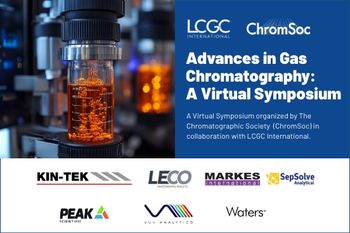
High Throughput Analysis for Food Safety and Cosmetics
This Tuesday afternoon session was arranged by Perry G. Wang of the U.S. Food and Drug Administration (US FDA) and Mark F. Vitha of Drake University.
Session 1260, Room 504bc, 1:30 p.m.
This Tuesday afternoon session was arranged by Perry G. Wang of the U.S. Food and Drug Administration (US FDA) and Mark F. Vitha of Drake University.
Vitha will preside over the session and start things off with his presentation titled “High Throughput Techniques for Food Analysis.” This presentation will provide an overview of high throughput food analysis and is intended to provide a general context for understanding the subsequent, more specific presentations that follow in the session.
Next, Wanlong Zhou of the US FDA will present a talk titled “Rapid and Simultaneous Determination of Harmful Chemicals in Nail Products by Gas Chromatography-Tandem Mass Spectrometry.” Zhou will discuss a rapid and sensitive gas chromatography–tandem mass spectrometry (GC–MS-MS) method that has been developed and validated to determine the level of harmful chemicals in nail products such as toluene, methylpyrrolidone, benzophenone-1, and diethylene glycol dimethacrylate.
The third talk in this session, Antibiotic Residue Detection by LC/MS/MS in Food,” will be given by Angela Carlson of SGS North America. Carlson will discuss the detectition of many classes of antibiotics in various food matrices that can be achieved using solid phase extraction (SPE) cleanup and analysis by high performance liquid chromatography with tandem mass spectrophotometry (HPLC–MS-MS).
Next, Xiang Zhang of the University of Louisville will give a talk titled “Impact of Chronic Ethanol Consumption on Metabolite Profiles of Liver in Mice: A Time Course Study.” Zhang will discuss the results of an investigation on the impact of chromic ethanol consumption on metabolite profiles of mouse liver. The derivatized samples were analyzed on a comprehensive two-dimensional gas chromatography time-of-flight mass spectrometer. The experimental data were first analyzed using the instrument software ChromaTOF for peak picking and compound identification, followed by MetPP software for retention index matching, alignment, normalization, quantification, and time course analysis.
After a brief recess, Pei Chen of the USDA with present a talk titled “A Mass Spectroscopic Fingerprinting Method for Authentication and Quality Assessment of Scutellaria lateriflora Based Dietary Supplements.” In this study, a flow injection electrospray ionization-mass spectrometry (ESI-MS) fingerprinting method in combination with principal component analysis (PCA) was used to survey Scutellaria lateriflora-based dietary supplements sold in the US.
Next, James Chang of Thermo Fisher Scientific will present “Micro Flow LC and its Application on Food Safety Analysis.” This paper presents an application of ultra-high performance liquid chromatography (UHPLC) and micro flow liquid chromatography (MFLC) coupled with electrospray ionization (ESI) quadrupole Orbitrap high resolution mass spectrometry (Q-Orbitrap) for the determination of ~500 pesticide residues in fruits and vegetables.
Finally, Kelly Dorweiler of General Mills/Medallion Laboratories will give a presentation titled “Improving Identification of Pesticides Using Atmospheric Pressure Gas Chromatography Coupled with Mass Spectrometry.” Dorweiler will discuss how atmospheric pressure ionization gas chromatography (APGC) provides a softer ionization of the analyte, preserving the molecular ion for better identification. Results will be presented including signal-to-noise of the molecular ions and key fragments for complex matrices including flaxseed and dried soybean.
Following the final presentation there will be an open discussion with the speakers and audience.
Newsletter
Join the global community of analytical scientists who trust LCGC for insights on the latest techniques, trends, and expert solutions in chromatography.




